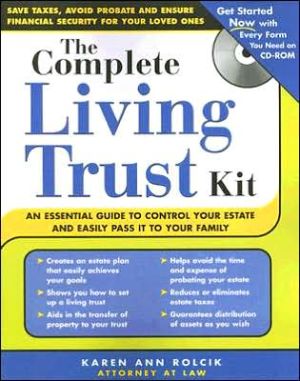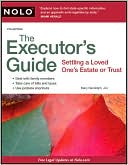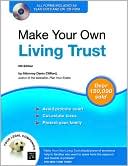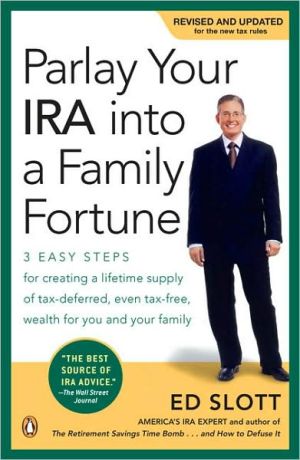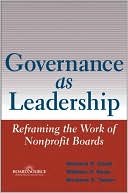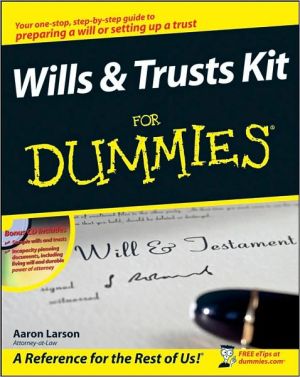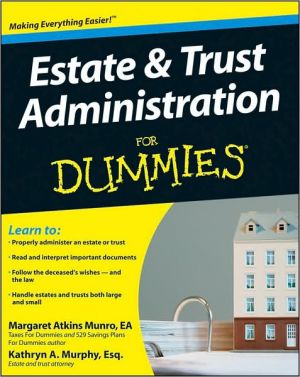Complete Living Trust Kit (+ CD-ROM)
Did you know that the government may be able to take nearly half of the assets you leave your family?\ Did you know that your family could have to wait to access the funds you saved for them?\ A Living Trust can do so much more than a will to ensure that money is not lost or wasted, to keep your family out of court and to keep creditors away. Let The Complete Living Trust Kit teach you all the advantages a Living Trust offers.\ A Living Trust is inexpensive to create, easy to maintain and:\...
Search in google:
A Living Trust is inexpensive to create, easy to maintain and difficult for others to contest. Let The Complete Living Trust Kit teach you all the advantages a Living Trust offers.
How to Calculate Your Net Worth\ Excerpted from Complete Living Trust Kit by Karen Ann Rolcik ©2007\ Identify Your Assets Your most recent tax return can be a very valuable resource in identifying your assets and liabilities. Copies of W-2s, Form 1099s, and Schedule K-1s are excellent reminders of assets you may have forgotten about. These documents will, in turn, lead you to such things as brokerage statements, bank statements, royalty statements, and loan interest summaries.\ Investments-Marketable Securities Stocks, bonds (including US savings bonds), mutual funds, United States Treasury bills and notes, and certificates of deposits should be included in the "Investments" section of the Inventory. Each investment should be listed individually, with a total for each category of investment. Brokerage statements, 1099-INT forms, and 1099-DIV forms are excellent resources from which detailed information can be obtained. Of course, the value of marketable securities fluctuates daily. You should use the most recent value available. The Inventory contains lines where you can list the dates on which you acquired the investment and the initial cost of the investment. This information will be useful in the future for calculating capital gains or losses when the investment is sold.\ Cash Cash and cash equivalents include your checking and savings accounts, money market funds, share accounts at credit unions, and similar accounts.\ Retirement /Employment Related Plans Retirement plans include employer-sponsored pension or profit-sharing plans, 401(k) (company savings) plans, Keogh or Simplified Employee Pension (SEP) programs, IRAs, deferred compensation plans, and employee stock option plans (ESOPs).\ Real Estate Real estate includes your home, vacation home(s), and any investment real estate, such as rental properties or apartments. If you have not had an appraisal or market analysis of your real estate done within the past two years, you can use property tax statements as a guide. Property tax statements often understate the market value of the real estate. A general rule is to increase the property tax value by 10% to obtain an estimated market value of your property. However, check with your county tax assessor's office to determine how it calculates property values.\ Of course, if you have made significant improvements to your real estate, such as room additions, remodeling, or upgrades, you should take the same into account. Remodeling and improvements do not increase the value of the property on a dollar-for-dollar basis. To avoid overstating the value, increase the market value by 75% of the cost of the remodeling and improvements. For instance, if you spent $3,000 to put ceramic tile in your kitchen, $3,000 to remodel your bathroom, and $5,000 to replace your windows, you should increase the value of your real estate by $7,500, instead of $10,000.\ Life Insurance Many life insurance policies do not have a cash value. Individual term and group term life insurance policies only provide a death benefit.While the death benefits of these policies do not affect your net worth, the death benefit increases the value of your estate for estate and inheritance tax purposes. Remember, credit life insurance benefits decrease as the outstanding balance of the loan decreases.\ Whole, universal, and variable life policies have a cash value. This cash value should be included on the Inventory. In addition, if you have taken loans against the policy, the loan should be taken into account in determining the net cash value of the policy.\ Business Interests If you own interest in a business, include the value of your ownership interest. This may be the value of common stock in a corporation, units in a limited liability company, or general or limited partnership interests in a limited partnership. If you operate an unincorporated business, such as a sole proprietorship, general partnership, or joint venture, include the value of your share of the net worth of the business.\ Personal Property Personal property includes furniture, household goods, automobiles, recreational vehicles (motor homes, boats, ATVs, etc.), clothing, furs, jewelry, tools, artwork, antiques, collectibles, and many other items. If you have items that are separately listed on your homeowners insurance policy-such as jewelry, artwork, or antiques-or for which you have a separate insurance policy, use the value for which you have these items insured.\ Miscellaneous Assets Promissory notes, annuities, oil and gas royalties, leasehold interests, and investments in commodities (including gold and silver) should be listed in this section.\ Identify Your Liabilities Many attorneys and financial planners calculate net worth without regard to most debts and liabilities owed by their client. Typically, the only debts that are taken into account are mortgages on real estate. Such an omission can significantly overstate a client's net worth. For example, many people have student loan obligations that exceed $50,000. Credit card debt can often exceed the amount of a car loan. In addition, personal loans-whether secured or unsecured-can be significant.\ Calculate Your Net Worth Now that you have identified your assets and liabilities, subtract the amount of your liabilities from the value of your assets in order to determine your net worth. Keep in mind that your net worth will fluctuate almost daily. This reflects things like the change in the value of your investments and the reduction in loan obligations.\ The process of determining your net worth gives you insight as to the type of living trust you should establish. As time passes and your financial situation changes, you will need to revisit your net worth, and if necessary, update your living trust to reflect your new financial position. For example, when you first read this book, you may determine that your net worth does not support a living trust that includes estate tax planning. As time goes by and the value of your estate increases, you may need to revise your living trust to include such planning.
Using Self-Help Law Books -Introduction -Chapter 1: Probate:The Good, The Bad, and The Ugly - Understanding the Probate Process Understanding when Probate is Necessary Property Subject to Probate The Role of Your Will in the Probate Process Disadvantages of Probate Advantages of Probate ConclusionChapter 2: Probate Alternatives and Beneficiary Designations: - Side Stepping the Probate Process - Benefits of Probate Alternatives Dangers of Probate Alternatives Methods of Holding Title to Assets Community Property Transfers of Property by Contract GiftsChapter 3: Estate and Inheritance Taxes: -Is Uncle Sam a Beneficiary of Your Estate? - Federal Estate Tax Planning to Reduce Your Estate Tax BurdenChapter 4: Living Trusts:The Nuts and Bolts - Trusts Trust Types Parties to a Trust Living Trust Advantages Living Trust DisadvantagesChapter 5: Your Assets:What Do You Have and How Much Do You Have? - Calculating Your Net Worth The Worksheet Identify Your Assets Retirement/Employment Related Plans Identify Your Liabilities Calculate Your Net Worth Net Worth Worksheet Net Worth Summary Personal Contacts WorksheetChapter 6: Creating Your Living Trust:Putting It All into Action - The Trustee The Beneficiaries Executing Your Living Trust Amending the Living Trust Revocation of the Living TrustChapter 7: Funding Your Living Trust:If You've Got It, Fund It! - Deciding which Property to Transfer Title Taxpayer IdentificationNumber Asset Ownership Transferring Assets to Your Living Trust Living Trust RecordkeepingChapter 8: Estate Tax and Probate Savings of Living Trusts:You Earn It, You Keep It! - I Love You Wills Case Studies Estate Tax Planning with Living Trust Family Trust Appreciation Guardianships-the Living ProbateChapter 9: Ancillary Documents to Avoid Living Probate: -Complete Your Planning with All the Documents You Need - Powers of Attorney-Guardianship Alternatives Declaration of Guardian in Advance of Need Designation of Guardian for Minor ChildrenChapter 10: Administration of Your Living Trust after Your Death: -The Final Steps - Obtain Death Certificates Gather Personal Information Contact Social Security Administration Safe Deposit Box Obtain Tax Identification Number for Trust Contact Life Insurance Companies Inventory Assets Identify Debts of Decedent Final Income Tax Return Trust Income Tax Returns Distribution of Assets to BeneficiariesEpilogue -Glossary -Appendix A: Tax Explanations and Charts -Appendix B: State-by-State Laws -Appendix C: The Design of the Forms -Appendix D: Blank Forms -Index -About the Author
